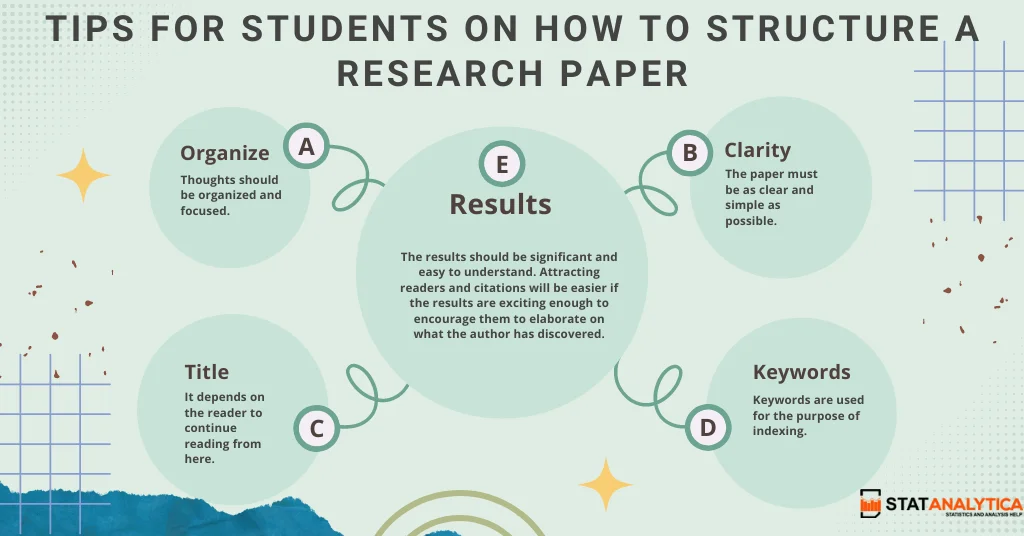
What Are The Key Elements of Research Paper Structure?

Writing a well-structured research paper is not everybody’s cup of tea. One may spend months or even years conducting one good research paper. Sometimes, it might become difficult even to start writing. Let alone thinking of the structure of the research paper.
It is truly said that a well-structured research paper is able to address a specific research question. It has the capacity to question the reader’s perspective and idea.
This article is authored with the view to make its viewers understand the importance of research structure and also give out tips on how to write the research paper structure.
On the other hand, as a research paper assignment helper , we understand the importance of a strong research paper structure. Let us help you create a winning paper that will impress your professors and earn you top marks.
What Is Research Paper?
Table of Contents
A research paper is a type of academic document that explores a particular topic in-depth. It involves conducting research, gathering information, and presenting findings in a structured manner. The purpose of a research paper is to contribute knowledge, provide information, or present arguments based on evidence.
In addition, it includes an introduction, body paragraphs with supporting evidence, and a conclusion. Research papers are commonly written by students, scholars, and professionals to share their research and contribute to their respective fields of study.
What Is Research Paper Structure?
The research structure is mainly an outline of the work. The structure consists of a number of sub-sections. We will learn about each in detail as you scroll down.
One is expected to provide the research structure towards the end of the introduction chapter of the dissertation. Most research papers have more or less the same structure.
It is important for the author to first make sure that the information/data is compiled and analyzed. This step is crucial in order to get the paper structured properly. It is also helpful for a better understanding of a particular topic. Providing clear definitions is one of the main aims of creating the structure of a research paper.
Why Is Research Paper Structure Important?
- Research paper structure improves the organization and coherence of information.
- It enhances the clarity and readability of the paper for readers.
- A clear structure helps researchers effectively convey their main points and arguments.
- It makes it easy navigation and quick access to specific sections or information.
- A well-defined structure demonstrates the researcher’s ability to present information effectively, enhancing the overall quality and impact of the paper.
Top 10 Key Elements Of Research Paper Structure You Must Know
As discussed above, the key to a successful and impressive research paper is getting its structure right. The basic structure of a general research paper goes in the sequence of the title page, abstract, introduction, materials and methods, results, and discussion of the same which is followed by the conclusion. References and acknowledgments are provided marking the end of the paper.
Each subsection points out a different objective for the main topic or the same point of interest. Below is a detailed description of each of the sub-sections:
1. Title page
The title page allows the reader to identify the work just by reading the title. It is the very first page any reader will come across. The title page must include the name of the author, the name of the course for which the research was performed, the name of the instructor, the date of completion, and the page number.
An individual must be able to understand the purpose of writing the research paper just by reading the title. This is the first section of the research paper structure.
2. Abstract
The abstract of a research paper should be a short summary of the contents it includes. It should be less than 250 words. Usually, it includes the purpose of the study, significant results, and its conclusion.
Since the abstract contains small bits of information about the article, it is best to call it an overview of the paper. An article’s abstract will always be available to view online whether or not you have paid for its subscription.
3. Introduction
After the abstract comes the introduction to the research. The introduction gives the reader all the primary information he or she requires to understand the paper. It must explain the idea of the main topic.
Explanation of the key terms, historical information, and citation of other studies revolving around the topic must follow. The introduction should be able to indicate why the research done in this particular article is different or how it is relevant to the discussion.
4. Materials and Methods
The Materials and Methods in the research paper explain to an individual how the study was conducted. Generally, it provides the reader with information like – the sampling strategy used, instruments, data collection methods, and analysis strategies.
This part of the information must be descriptive, precise, and in detail.
The results of an article should give specific information on what the findings are, and their value, with suitable data included.
It must be presented in a straightforward and factual manner. Numerical figures, graphs, and percentages should be included as well.
6. Discussion
Discussion of an article is also known as the ‘body’. Facts are focused on in this section. It is considered the most difficult part to write.
Discussion must be put before or after the results. This section must be able to answer questions like: is the analysis matching with the calculated data, is the conclusion valid, and does the discussion prove the required point? Discuss what the results show in this particular section.
7. Conclusion
The Conclusion tells one about the final thoughts of the author. It is a paraphrased version of the overall discussion in short.
Containing an average of 100 to 200 words, it covers all the main keywords and points. It may repeat what is already noted in the discussion. It may also provide recommendations for future research.
8. References
The reference page allows the author to accept all the sources used for gathering information. The resource should be cited properly.
Examples of citations can be found on the website online. Reference to any online source that the reader will have trouble finding or understanding should be avoided for use.
9. Acknowledgements
Acknowledgments are used to thank any persons or institutions that made the research possible. An individual can extend their gratitude towards the person or organization under this section for helping him/her get through the research paper within the stipulated time period and guiding them.
10. Appendix (if any add-ons were available)
In some cases, an appendix in a research paper contains non-evaluative information that is not important for comprehending the research paper, such as a list of experiment encouragement, details of a secondary scanning, or programming code. This is usually found in an appendix. This is the last section of the research paper structure.
- How to write research paper outline
- How to write research paper
How Long Should A Research Paper Be?
The length of a research paper depends on the assignment requirements, the field of study, and the course level. In general, research papers can range from 5 to 30 pages or more, with the average length being 10-15 pages.
On the other hand, in many cases, instructors or journals may provide specific guidelines for the length of the paper, including the number of pages or word count. If such guidelines are not provided, it is important to consider the complexity of the topic and the amount of research required to address it sufficiently.
It is also important to remember that the length of a research paper should not be the primary focus. The research, analysis, and writing quality are much more important than the number of pages. A well-written, concise paper that effectively addresses the research question is often more valuable than a longer paper that is poorly organized and does not provide a clear argument.
So this means that you do not have to write a long and poorly organized paper. However, it is better to write a proper and well-written research paper.
Tips On How To Improve Your Research Paper Structure


1. Organize
Thoughts should be organized and focused. Ask yourself what idea you want to convey to the reader. Is there a message hidden in the paper? Is more research required?
These questions must be solved to help one to keep their focus on the goal. This is the first tip on how you can improve your research paper structure.
The paper must be as clear and simple as possible. The language should not be difficult to understand. The sentence structure must be short and simple.
Along with that, it is very important that all the data and facts are accurately presented.
The title and abstract are the first two sections of the paper that the reader will read. It depends on the reader to continue reading from here.
Thus, it is crucial for both the title and abstract to be eye-catching and effective at the same time. It must be able to summarize the entire paper for the reader.
4. Keywords
Keywords are used for the purpose of indexing. Indexing is the process of finding words easily online. Words that are specific and do not already exist in the title are ideal.
Depending on the research paper, keywords that appear in the title must be often avoided.
The results should be significant and easy to understand. Attracting readers and citations will be easier if the results are exciting enough to encourage them to elaborate on what the author has discovered.
This is the last tip on how you can improve your research paper structure.
Tools And Resources To Write A Good Research Paper Structure
Research paper outline template: A template is a helpful tool that can help you to structure your research paper efficiently. With a template, you will have a clear idea of the different sections of your paper and how they should be arranged. Several outline templates are available online, and you can use them as a guide to creating your outline.
1. Library databases
Libraries are an excellent resource for finding academic sources. Many libraries have databases that you can access online, which contain a wide range of scholarly articles, books, and other materials that are relevant to your research. You can use these databases to find reliable sources for your paper.
2. Citation tools
Proper citation is crucial in academic writing. A citation tool can help you to format your citations correctly and avoid plagiarism. Several citation tools, such as EasyBib, Zotero, and Mendeley, are available. These tools can save you time and ensure your citations are accurate.
3. Writing software
Writing software can help you to organize your research and write your paper efficiently. Some popular writing software includes Microsoft Word, Google Docs, and Scrivener. These tools have features that can help you to structure your paper, such as outlining, formatting, and citation management.
4. Grammar and spell-checking tools
You must proofread your paper to ensure it’s error-free. Grammar and spell-checking tools can help you to catch any mistakes that you have missed. Some popular tools include Grammarly, Hemingway Editor, and ProWritingAid.
5. Writing guides and manuals
Several guides and manuals are available online to help you write a good research paper. Some popular ones include The Chicago Manual of Style, The MLA Handbook, and The APA Publication Manual. These guides provide detailed instructions on formatting, citation, and writing style.
These tools and resources can help you structure your research paper effectively, write it clearly, and present it professionally.
Conclusion on research paper structure
In conclusion, we have a clear insight as to what the research paper structure is. It is mainly described as the outline of the work. The research paper is written keeping nine sub-sections in mind. Without each section, the paper tends to look incomplete. Each sub-section offers a different objective for the main topic.
Most research papers usually follow the same structure. Here, we have also learned certain tips on how to improve your research paper structure. If you want to get the best research paper writing help then you get help in touch with our research paper helper .
Q1. What are the 5 parts of a research paper?
A full research paper that is in APA format reporting on experimental research will typically include the following sections: Title page, Abstract, Introduction, Methods, Results, Discussion, and References.
Q2. What are the main parts of a research paper?
There are 9 main parts in a research paper:
1. Title (cover page) 2. Introduction 3. Literature review 4. Research Methodology 5. Data analysis 6. Results 7. Conclusion 8. Reference page 9. Appendix (if any add-ons were available)
If you follow this structure, you will end up with a concise, well-organized research paper.
Q3. How to write a research paper?
If you want to write a good Research Paper then here are some tips for you: 1. Choose a topic. 2. Read and keep records. 3. Form a thesis. 4. Create a mind map or outline. 5. Read again. 6. Rethink your thesis. 7. Draft the body. 8. Revise.
Q4. How Can You Understand The Research Paper Assignment?
Completing a research paper successfully usually involves completing the tasks assigned to you. Before you begin, ensure you have a proper understanding of the assignment task sheet. Here are some tips on how you can understand the research paper assignment:
1. Determine the goal, deadline, length requirements, formatting, and submission method for the assignment. 2. You can make a bulleted list of the main points you wanted in your research paper, then go back and check off completed items as you write. 3. Read it carefully, looking for any confusion you may need to clarify with your professor. 4. You can consider your timeframe and word limit very carefully. On the other hand, it is very important to be more realistic and allow enough time to research, write, and edit.
Q5. Summarize The Major Elements Of The Paper?
Here are the major elements of the research paper structure:
1. Introduction 2. Literature Review 3. Research Methodology 4. Results 5. Discussion 6. Conclusion 7. References (or Bibliography) 8. Appendices (if applicable)
Related Posts

Step by Step Guide on The Best Way to Finance Car

The Best Way on How to Get Fund For Business to Grow it Efficiently

IMAGES
VIDEO